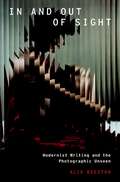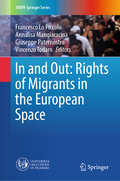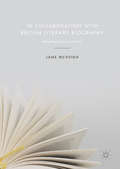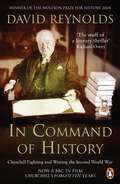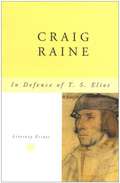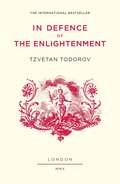- Table View
- List View
In and out of Bloomsbury: Biographical essays on twentieth-century writers and artists
by Martin Ferguson SmithThese highly original essays illuminate Virginia Woolf and a selection of other twentieth-century writers and artists. Based on detailed research and presenting previously unpublished texts, pictures, and photographs, they are notable feats of scholarly detective work. Six of them focus on four pivotal members of the Bloomsbury Group – Virginia Woolf, Vanessa Bell, Clive Bell, and Roger Fry. Prominent ingredients of their story include art, writing, friendship, love, sex, mental illness, and Greek travel. The five ‘out of Bloomsbury’ essays are about the ‘new’ letters from the novelist Rose Macaulay to the Irish poet Katharine Tynan; the prodigious teenage talents of Dorothy L. Sayers; the remarkable story of Tolkien’s schoolmaster R. W. Reynolds; and the artist Tristram Hillier in Portugal. The collection creates a richly varied and entertaining picture of British culture in the first half of the twentieth century.
In and Out of Sight: Modernist Writing and the Photographic Unseen (Modernist Literature and Culture)
by Alix BeestonIn a post-digital media landscape tracked endlessly by streams and feeds of images, it is clearer than ever that photography is an art poised between arresting singularity and ambiguous plurality. Drawing on work in visual culture studies that emphasizes the interplay between still and moving images, In and Out of Sight provides a provocative new account of the relationship between photography and modernist literature--a literature which has long been considered to trace, in its formal experimentation, the influence of modern visual technologies. Making pioneering claims about the importance of photography to the writing of Gertrude Stein, Jean Toomer, John Dos Passos, and F. Scott Fitzgerald, Alix Beeston traverses the history of photography in the late nineteenth and early twentieth centuries. From the composite experiments of Francis Galton to the epic portrait project of August Sander; from the surrealist self-fashioning of Claude Cahun to the reappropriation of lynching photographs by black activist groups; from the collectable postcards of Broadway stars to the glamour shots of Hollywood celebrities-these and other serialized photographic projects provide essential contexts for understanding the fragmentary, composite forms of literary modernism. In a series of richly detailed literary analyses, Beeston argues that the gaps and intervals of the composite literary text model the visual syntax of photography--as well as its silences, absences, and equivocations. In them, the social and political order of modernity is negotiated and reshaped. Moving in and out of these textual openings, In and Out of Sight pursues the fleeting, visible and invisible figure of the woman-in-series, who recasts absence and silence as forms of presence and witness. This shadowy figure emerges as central to the conceptual space of modernist literature--a terrain not only gendered but radically constructed around the instability of female bodies and their desires.
In and Out: Rights of Migrants in the European Space (UNIPA Springer Series)
by Francesco Lo Piccolo Annalisa Mangiaracina Giuseppe Paternostro Vincenzo TodaroThis book examines contemporary migratory movements, starting from the European zone, but with an extension to other territorial contexts as well, with research orientation that focuses on the account of the migratory experiences collected in the research activity of the different authors, according to a multidisciplinary dimension. Starting from these key topics, the authors articulated and further developed its reflections through its own experiences at the national and international level, taking root within the current scientific debate on migration. The interdisciplinary approach and the different and innovative ways of analysing in depth the thematic contents of the migration phenomenon have made it possible to identify some key research questions. The relative answers find space in the articulated and complex system of contributions that is developed within this book and in particular in the three thematic parts into which it is divided. The first one deals with the theme of migration confronted with issues related to the 'right to the city' and the 'right to housing'; the second one deals with issues related to human rights; finally, the third one focuses on the different narratives of migrants' life experiences and aspects related to the linguistic representation of the urban space.
In Arden: Editing Shakespeare - Essays In Honour of Richard Proudfoot
by Gordon McMullan Ann ThompsonA collection of new and specially commissioned essays by an eminent team of Shakespeare scholars, focusing on the particular issues relating to the editing of Shakespeare and other Renaissance texts. The editing of dramatic and other literary texts has always been an important aspect of literary studies. In recent years, editing and the theoretical frameworks that underlie editing practices have become a lively and controversial focus of debate, sparked both by philosophical discussions on 'the death of the author' and by the technological challenges presented by the possibilities of electronic texts. Most national and international conferences on literature and drama include sessions on textual studies and editing, and a number of monographs address particular issues relating to the editing of Shakespeare and other Renaissance texts, but this is the first overall survey of the current state of the field. The essays have been commissioned to honour Professor Richard Proudfoot, Senior General Editor of the Arden Shakespeare, and an internationally recognised authority in the field of Shakespeare textual scholarship, who retired from King's College London in 1999 after 35 years. This is a well-planned, focused and co-ordinated volume makes a significant contribution to Shakespeare studies. The contributors are a formidable and global group of scholars, representing both traditional and contemporary viewpoints. They include a number of Arden editors, past and present, as well as scholars who have edited texts for the main competitors.
In Arden: Editing Shakespeare (Arden Shakespeare Ser.)
by Ann Thompson Gordon McMullanA collection of new and specially commissioned essays by an eminent team of Shakespeare scholars, focusing on the particular issues relating to the editing of Shakespeare and other Renaissance texts. The editing of dramatic and other literary texts has always been an important aspect of literary studies. In recent years, editing and the theoretical frameworks that underlie editing practices have become a lively and controversial focus of debate, sparked both by philosophical discussions on 'the death of the author' and by the technological challenges presented by the possibilities of electronic texts. Most national and international conferences on literature and drama include sessions on textual studies and editing, and a number of monographs address particular issues relating to the editing of Shakespeare and other Renaissance texts, but this is the first overall survey of the current state of the field. The essays have been commissioned to honour Professor Richard Proudfoot, Senior General Editor of the Arden Shakespeare, and an internationally recognised authority in the field of Shakespeare textual scholarship, who retired from King's College London in 1999 after 35 years. This is a well-planned, focused and co-ordinated volume makes a significant contribution to Shakespeare studies. The contributors are a formidable and global group of scholars, representing both traditional and contemporary viewpoints. They include a number of Arden editors, past and present, as well as scholars who have edited texts for the main competitors.
In Between Communication Theories Through One Hundred Questions (Numanities - Arts and Humanities in Progress #14)
by Tomas Kačerauskas Algis MickūnasThis book takes the form of a dialogue. It presents two authors, specialized in the phenomenologу, posing questions to each other and offering complex answers for critical discussion. The book includes both presentation of different communication schools and philosophizing on the issues of communication. The authors debate numerous topics by providing the definition and etymology of communication, examining the limits of communication, and using a poli-logical base of communication. The issue which pervades all domains is that of mediation: how things, such as identities, styles, and bodies are mediated by culture, history, and tradition, and what the limits are of such mediation. This question leads to more complex issues of “mediated mediations” such that an explication of one medium is framed by another medium, leading to a question of meta-language as a fundamental, unmediated medium. This involves some fine points of mediation: perspectivity, discursivity, ethics of communication, ideology, private and public. Throughout the mutual, interrogative dialogue, the authors touch upon, but avoid the daunting commitment to, a theory of metacommunication, as well as the “transcendental” problematic of accessing the numerous theoretical, thematic, and historical aspects of communication.
In Bewegung: Die Produktion von Web-Videos bei deutschen regionalen Tageszeitungen
by Matthias WalterIn Byron's Shadow: Modern Greece in the English and American Imagination
by David RoesselModern Greece, constructed by the early nineteenth-century ideals and ideas associated with Byron, has been "haunted, holy ground" in English and American literature for almost two centuries. In Byron's Shadow analyzes how authors employ ideas about romantic nationalism, gender politics, shifts in cultural constructions, and literary experimentation to create variations of "Greece" to suit changing eras.
In Byron's Shadow: Modern Greece in the English and American Imagination
by David RoesselModern Greece, constructed by the early nineteenth-century ideals and ideas associated with Byron, has been "haunted, holy ground" in English and American literature for almost two centuries. In Byron's Shadow analyzes how authors employ ideas about romantic nationalism, gender politics, shifts in cultural constructions, and literary experimentation to create variations of "Greece" to suit changing eras.
In Collaboration with British Literary Biography: Haunting Conversations
by Jane McveighThis book is about one person’s reading and what has been learnt about how the lives of other people, particularly authors, have been written in British literary biographies over the last fifty years. It is less interested in what happened in the lives of the people described in these biographies, and more concerned with how these stories have been told. It aims to have a conversation with British biographers, particularly Michael Holroyd, Richard Holmes, Hermione Lee and Claire Tomalin, to make their voices heard, to set them talking. It understands biography as an ongoing collaboration, not only between biographers and their subjects, but between biographers and their readers. This is also a study of haunting, in which we haunt the lives of others to help us come to a better understanding of our own.
In Collaboration with British Literary Biography: Haunting Conversations
by Jane McveighThis book is about one person’s reading and what has been learnt about how the lives of other people, particularly authors, have been written in British literary biographies over the last fifty years. It is less interested in what happened in the lives of the people described in these biographies, and more concerned with how these stories have been told. It aims to have a conversation with British biographers, particularly Michael Holroyd, Richard Holmes, Hermione Lee and Claire Tomalin, to make their voices heard, to set them talking. It understands biography as an ongoing collaboration, not only between biographers and their subjects, but between biographers and their readers. This is also a study of haunting, in which we haunt the lives of others to help us come to a better understanding of our own.
In Command of History: Churchill Fighting and Writing the Second World War
by DR David ReynoldsChurchill fought the war twice over - as Prime Minister and again as its premier historian. In 1948-54 he published six volumes of memoirs which secured his reputation and shaped our understanding of the conflict to this day. Using the drafts and correspondence for The Second World War, David Reynolds opens our eyes to Churchill the author and to the research 'syndicate' on whom he depended. We see how the memoirs were censored by Whitehall to conceal secrets such as the codebreakers at Bletchley Park, and how Churchill himself censored them to avoid offending current world leaders. This book forces us to reconsider much received wisdom about the war and illuminates an unjustly neglected period of his life - the Second Wilderness Years of 1945-51, when Churchill, now over seventy, wrote himself into history, politicked himself back into Downing Street and delivered some of the most important speeches of his career.
In Conversation with Bessie Head
by Mary S. LedererIn Conversation with Bessie Head shows how reading the novels and letters of Botswana's most influential writer, Bessie Head, fosters an ongoing conversation between reader and writer and is in fact a very personal undertaking. Each chapter tackles two parallel threads, the first regarding Mary S. Lederer's own history of reading Head-from her first purchase of Maru, through completing a Ph.D. on Head's trilogy, through living in Botswana and connecting with various aspects of Head's life, to examining how reading Head has affected her own development as a human being. This history then ties each chapter into discussion of how Head develops her own vision of the “brotherhood of man.” Alongside critically informed discussion, Head's vision is examined through the prism of specific questions. Why is madness not a useful concept for understanding Head's ideas? Why did Head say she was not a feminist, and what is the significance of “male” and “female” in her novels? What is the relationship between individual, race, and community? How can the nature of God be a clear expression of love but also an indistinct force for both good and evil? Head's novels present opportunities for personal growth, and through these “conversations” with her, we become different readers.
In Conversation with Bessie Head
by Mary S. LedererIn Conversation with Bessie Head shows how reading the novels and letters of Botswana's most influential writer, Bessie Head, fosters an ongoing conversation between reader and writer and is in fact a very personal undertaking. Each chapter tackles two parallel threads, the first regarding Mary S. Lederer's own history of reading Head-from her first purchase of Maru, through completing a Ph.D. on Head's trilogy, through living in Botswana and connecting with various aspects of Head's life, to examining how reading Head has affected her own development as a human being. This history then ties each chapter into discussion of how Head develops her own vision of the “brotherhood of man.” Alongside critically informed discussion, Head's vision is examined through the prism of specific questions. Why is madness not a useful concept for understanding Head's ideas? Why did Head say she was not a feminist, and what is the significance of “male” and “female” in her novels? What is the relationship between individual, race, and community? How can the nature of God be a clear expression of love but also an indistinct force for both good and evil? Head's novels present opportunities for personal growth, and through these “conversations” with her, we become different readers.
In Conversation with Bessie Head
by Mary S. LedererIn Conversation with Bessie Head shows how reading the novels and letters of Botswana's most influential writer, Bessie Head, fosters an ongoing conversation between reader and writer and is in fact a very personal undertaking. Each chapter tackles two parallel threads, the first regarding Mary S. Lederer's own history of reading Head-from her first purchase of Maru, through completing a Ph.D. on Head's trilogy, through living in Botswana and connecting with various aspects of Head's life, to examining how reading Head has affected her own development as a human being. This history then ties each chapter into discussion of how Head develops her own vision of the “brotherhood of man.” Alongside critically informed discussion, Head's vision is examined through the prism of specific questions. Why is madness not a useful concept for understanding Head's ideas? Why did Head say she was not a feminist, and what is the significance of “male” and “female” in her novels? What is the relationship between individual, race, and community? How can the nature of God be a clear expression of love but also an indistinct force for both good and evil? Head's novels present opportunities for personal growth, and through these “conversations” with her, we become different readers.
In Conversation with Bessie Head
by Mary S. LedererIn Conversation with Bessie Head shows how reading the novels and letters of Botswana's most influential writer, Bessie Head, fosters an ongoing conversation between reader and writer and is in fact a very personal undertaking. Each chapter tackles two parallel threads, the first regarding Mary S. Lederer's own history of reading Head-from her first purchase of Maru, through completing a Ph.D. on Head's trilogy, through living in Botswana and connecting with various aspects of Head's life, to examining how reading Head has affected her own development as a human being. This history then ties each chapter into discussion of how Head develops her own vision of the “brotherhood of man.” Alongside critically informed discussion, Head's vision is examined through the prism of specific questions. Why is madness not a useful concept for understanding Head's ideas? Why did Head say she was not a feminist, and what is the significance of “male” and “female” in her novels? What is the relationship between individual, race, and community? How can the nature of God be a clear expression of love but also an indistinct force for both good and evil? Head's novels present opportunities for personal growth, and through these “conversations” with her, we become different readers.
In Defence of T. S. Eliot
by Craig RaineHis pieces, on the literary world and some of its most fascinating figures and classics, bear his hallmark of vitality and distinctive approach. Raine’s knowledge of the span of literary theory (and anecdote) and the incisiveness of his thinking uncover as far more contradictory and complex in their successes writers customarily held in reverence. The essays range from a powerful piece on the KGB’s literary archive to thoughts about tragedy in Kipling’s life, from Auden, Nabokov and Beckett to the state of health of Samuel Johnson’s testicles. This book celebrates the diversity of the world of books and Raine is a supremely entertaining and thought-provoking guide. ‘Raine pounces on writers lacking his own high degree of linguistic resolution and independence. The citizenly impulse behind these arresting critical interventions is usually commendable. One gets the impression of a man simmering in long silence, coming reluctantly to the boil because someone has to speak up’ Geoff Dyer, Guardian
In Defence of the Enlightenment
by Tzvetan TodorovTzvetan Todorov argues that although our liberal democracies are the offspring of the Enlightenment, they also illustrate the ways in which its ideas have been distorted and perverted. People living in contemporary democracies are often baffled by phenomena which resist easy judgement: globalisation and media omnipotence; disinformation and state-sponsored torture; moralism and the right of intervention; the dominance of economics and the triumph of technology. In this book, Todorov shows that we cannot learn lessons from the past unless we know how to relate them to the present. He demonstrates that what remains relevant to today is the spirit expressed in the core principles and values for which the Enlightenment stood. In a period of great uncertainty, In Defence of the Enlightenment could not be more timely.
In Defense of Don Giovanni: A Feminist Mythobiography
by Luisa PasseriniWho wants to champion the figure of Don Giovanni in the time of Harvey Weinstein and #MeToo? Don Giovanni is a rapist, murderer, serial seducer, and liar. Can he ever be held up as a role model or seen as a figure to be enjoyed? This is the task that the eminent Italian historian and lifelong feminist, Luisa Passerini, sets for herself in In Defense of Don Giovanni. As she developed the long arc of her distinguished career, Don Giovanni surprisingly became not only her role model but also a secret object of research. Taking her method from oral history, Passerini creates a series of characters with whom she discusses the forms and incarnations of the myth of Don Giovanni across time, from its first appearance in early medieval Spain and Commedia dell’Arte to its many European variations and its transposition to the colonial and postcolonial world in the Middle East, the Americas, and Africa. Pivoting round Don Giovanni’s best known incarnation in Mozart’s opera, Passerini and her interlocutors meet in different locations from Venice and Bern to Paris and Turin. They discuss plays, films, and operas and talk about art, novels, and psychoanalytic interpretations of the myth while also sharing their own life stories, in which Don Giovanni often plays a part that is, by turns, destructive, mischievous, and full of the joy of life. From his early beginnings in the Iberian Peninsula to recent analysis of the sexuality of colonial conquest and postcolonial revenge and return, Don Giovanni shape-shifts between rapacious hypermasculinity, comic trickster, and morally vacuous loser whose annoyingly persistent nemesis Don Ottavio emerges as an alternative and ultimately better object of desire. As she tracks Don Giovanni’s image across the world and through the centuries, however, Passerini comes to see that it also plays another role, that of a mirror, in which women can see themselves emerge as individuals with their own life force.
In Defense of Polemics (Argumentation Library #42)
by Ruth AmossyThis book revisits the definition of polemical discourse and deals with its functions in the democratic sphere. It first examines theoretical questions concerning the management of disagreement in democracy and the nature of polemical discourse. Next, it analyses case studies involving such issues as the place of women in the public space, illustrated by the case of the burqa in France and public controversy in the media on the exclusion of women from the public space. The book then explores reason, passion and violence in polemical discourse by means of cases involving confrontations between secular and ultra-orthodox circles, controversies about the Mexican Wall and fierce discussions about stock-options, and bonuses in times of financial crisis.Although polemical exchanges in the public sphere exacerbate dissent instead of resolving conflicts, they are quite frequent in the media and on the Net. How can we explain such a paradox? Most studies in argumentation avoid the question: they mainly focus on the verbal procedures leading to agreement. This focus stems from the centrality conferred upon consensus in our democratic societies, where decisions should be the result of a process of deliberation. What is then the social function of a confrontational management of dissent that does not primarily seek to achieve agreement? Is it just a sign of decadence, failure and powerlessness, or does it play a constructive role? This book answers these questions.
In Defense of Read-Aloud: Sustaining Best Practice
by Steven LayneAs accountability measures for schools and teachers continue to grow, instructional practice is under the microscope. The practice of reading aloud to children may be viewed by some educators as an extra bit of fluff used solely for the purposes of enjoyment or filling a few spare minutes,but researchers and practitioners stand in solidarity: the practice of reading aloud throughout the grades is not only viable but also best practice.In Defense of Read-Aloud: Sustaining Best Practices, author Steven Layne reinforces readers' confidence to continue the practice of reading aloud and presents the research base to defend the practice in grades K12. Layne also offers significant practical insights to strengthen instructional practice-;answering the questions of Why should we?- and How should we? and provides practical advice about how to use read-alouds most effectively.Leading researchers in the field of literacy provide position statements, authors of professional books share insights on books they have loved, leaders of the largest literacy organizations in the United States write about their favorite read-alouds, award-winning authors of children's and young adult book (Katherine Paterson, Andrew Clements, Lois Lowry, to name a few) share the powerful behind-the-scenes stories of their greatest books, and real classroom teachers and librarians speak about books that have lit up- their classrooms and libraries around the world.Last but not least,In Defense of Read-Aloud features many great recommendations of books to share with children.Read-aloud is an essential practice in teaching literacy in grades K -12. In this book, Steven Layne has provided everything needed to support, sustain, and celebrate the power of read-aloud.
In Defense of Read-Aloud: Sustaining Best Practice
by Steven LayneAs accountability measures for schools and teachers continue to grow, instructional practice is under the microscope. The practice of reading aloud to children may be viewed by some educators as an extra bit of fluff used solely for the purposes of enjoyment or filling a few spare minutes,but researchers and practitioners stand in solidarity: the practice of reading aloud throughout the grades is not only viable but also best practice.In Defense of Read-Aloud: Sustaining Best Practices, author Steven Layne reinforces readers' confidence to continue the practice of reading aloud and presents the research base to defend the practice in grades K12. Layne also offers significant practical insights to strengthen instructional practice-;answering the questions of Why should we?- and How should we? and provides practical advice about how to use read-alouds most effectively.Leading researchers in the field of literacy provide position statements, authors of professional books share insights on books they have loved, leaders of the largest literacy organizations in the United States write about their favorite read-alouds, award-winning authors of children's and young adult book (Katherine Paterson, Andrew Clements, Lois Lowry, to name a few) share the powerful behind-the-scenes stories of their greatest books, and real classroom teachers and librarians speak about books that have lit up- their classrooms and libraries around the world.Last but not least,In Defense of Read-Aloud features many great recommendations of books to share with children.Read-aloud is an essential practice in teaching literacy in grades K -12. In this book, Steven Layne has provided everything needed to support, sustain, and celebrate the power of read-aloud.
In Defense of Reading: Teaching Literature in the Twenty-First Century (Wiley-Blackwell Manifestos)
by Daniel R. SchwarzWritten by influential scholar-critic and award-winning Daniel R. Schwarz, In Defense of Reading: Teaching Literature in the Twenty-First Century is a passionate and joyful defense of the pleasures of reading. This stimulating book provides valuable insights for teachers and students on why we read and how we read when we embark on "the odyssey of reading." Provides valuable insights into why and how we read Addresses issues and problems in the contemporary university and offers insights into the future Explores the life of the mind, the rewards and joys of committed teaching, and the relationship between teaching and scholarship in the contemporary university Draws on the author's forty years of teaching experience Following his long term commitment to close reading and historicism, Schwarz shows how the best literary criticism must both respect text and context Contains insightful and important readings of a broad range of texts, including those by Joyce, Woolf, Conrad, Forster, Gordimer, and Spiegelman's Maus

